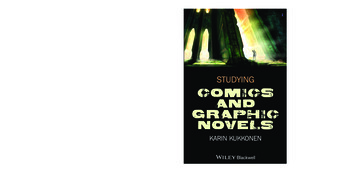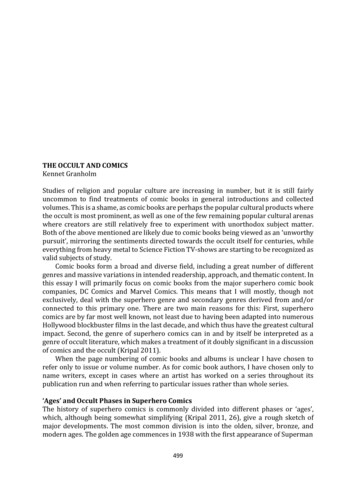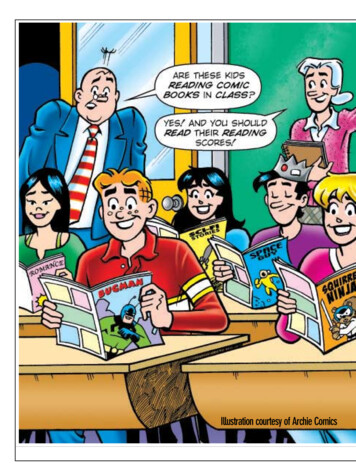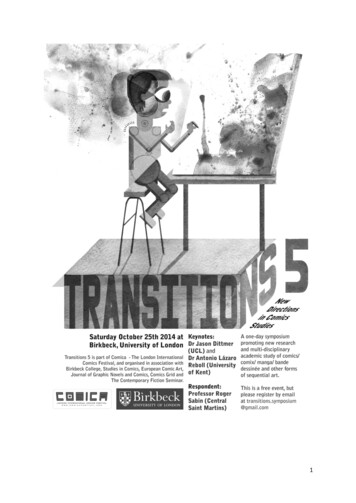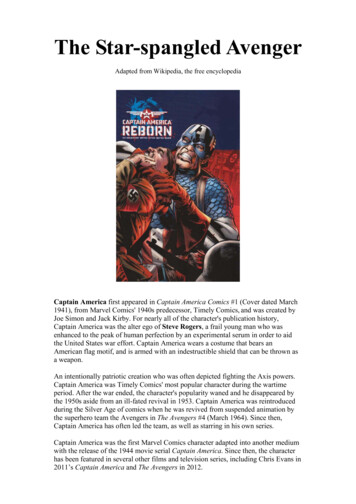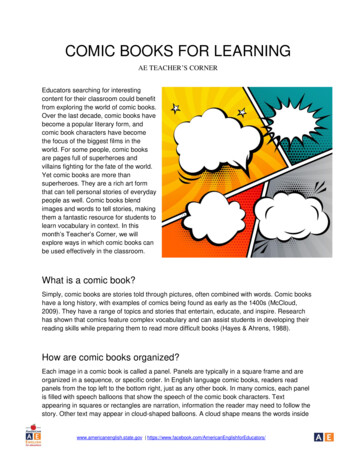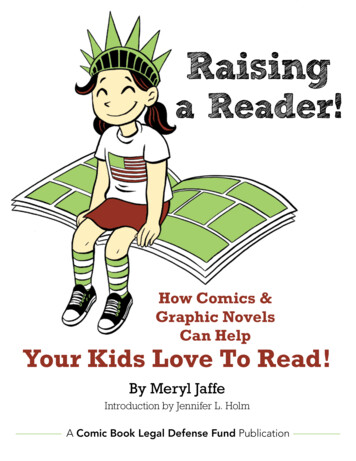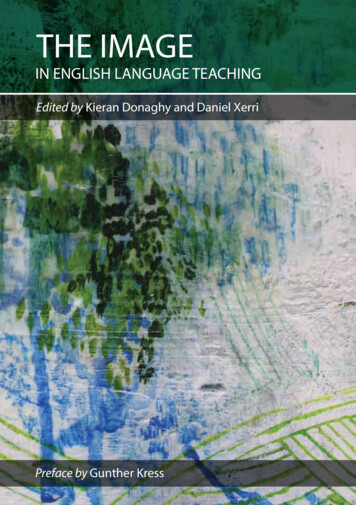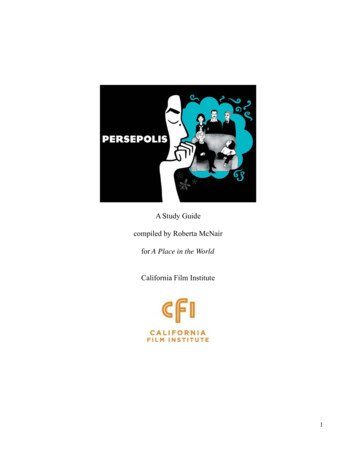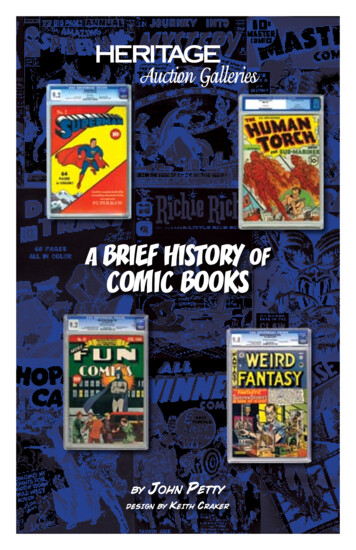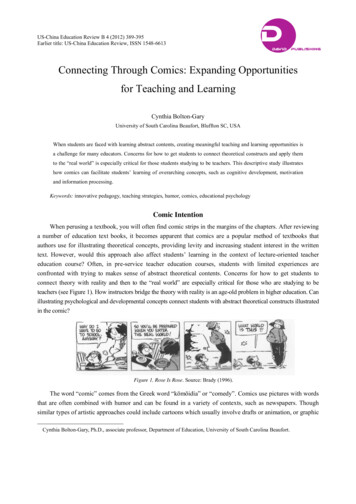
Transcription
DUS-China Education Review B 4 (2012) 389-395Earlier title: US-China Education Review, ISSN 1548-6613DAVIDPUBLISHINGConnecting Through Comics: Expanding Opportunitiesfor Teaching and LearningCynthia Bolton-GaryUniversity of South Carolina Beaufort, Bluffton SC, USA When students are faced with learning abstract contents, creating meaningful teaching and learning opportunities isa challenge for many educators. Concerns for how to get students to connect theoretical constructs and apply themto the “real world” is especially critical for those students studying to be teachers. This descriptive study illustrateshow comics can facilitate students’ learning of overarching concepts, such as cognitive development, motivationand information processing.Keywords: innovative pedagogy, teaching strategies, humor, comics, educational psychologyComic IntentionWhen perusing a textbook, you will often find comic strips in the margins of the chapters. After reviewinga number of education text books, it becomes apparent that comics are a popular method of textbooks thatauthors use for illustrating theoretical concepts, providing levity and increasing student interest in the writtentext. However, would this approach also affect students’ learning in the context of lecture-oriented teachereducation course? Often, in pre-service teacher education courses, students with limited experiences areconfronted with trying to makes sense of abstract theoretical contents. Concerns for how to get students toconnect theory with reality and then to the “real world” are especially critical for those who are studying to beteachers (see Figure 1). How instructors bridge the theory with reality is an age-old problem in higher education. Canillustrating psychological and developmental concepts connect students with abstract theoretical constructs illustratedin the comic?Figure 1. Rose Is Rose. Source: Brady (1996).The word “comic” comes from the Greek word “kōmōidía” or “comedy”. Comics use pictures with wordsthat are often combined with humor and can be found in a variety of contexts, such as newspapers. Thoughsimilar types of artistic approaches could include cartoons which usually involve drafts or animation, or graphicCynthia Bolton-Gary, Ph.D., associate professor, Department of Education, University of South Carolina Beaufort.
390EXPANDING OPPORTUNITIES FOR TEACHING AND LEARNINGnovels and a much more detailed story of episode, this paper will focus on the short and stand-alone comic strips.The research on using comics as a pedagogical tool for teaching and learning dates back to the 1940s and mostlyfocused on emerging literacy (Hutchinson, 1949; Sones, 1944). Incorporating texts with visual representationswhile teaching young children to read contributed to increasing children’s attention due to novelty and incongruity,more elaborate retrieval strategies and positive emotions are associated with learning (Jacobs, 2007; McVicker,2007; Schmidt, 1994; as cited in Martin, 2007). McVicker (2007) stated that, “Cartoons can be used to enhanceand support the learning that goes on in any classroom in versatile and creative ways” (p. 87).Although there are few experimental research designs in education, Ziv (1988), Schmidt and Williams(2001) and Schmidt (2002) had documented positive student learning gains when humor is used effectively inthe course of instruction. Nagata (1999) found that using manga (Japanese comics and cartoons) helpedstudents in biochemistry “use additional information and provide cognitive-psychological andpedagogical-technical effects: They give students clues to remember what they have learnt and makebiochemistry lectures exciting” (p. 203). Martin (2007) stated that, “Humor serves as a sort of mnemonictechnique or memory aid, causing greater elaboration of information and therefore enhancing its transfer andstorage in long-term memory” (p. 104). Through humor and pictures, comics can illustrate key points and“lighten” the classroom setting. This type of dual processing, emotional (humor) and visual (pictures/text), canhelp level the playing field for students trying to accommodate abstract content. Ziv (1988) and Martin (2007)noted that humor should be directly related to the content and student learning, not just merely forentertainment. Selectivity of the stimuli is important with attention devoted to novelty, incongruity and surprise,while refraining from sarcasm and crassness (Ziv, 1988).Comic ExtensionTypical content covered in an introduction to educational psychology course includes an overview ofdevelopmental theory and individual differences with emphasis on Piaget’s stages of cognitive development andbasic tendencies of thought, Vygotsky’s socio-historical theory, Erikson’s stages of individual development,Bandura’s social learning theory, brain research, intelligence and diversity. Other core concepts covered includetheories of learning and motivation, instructional planning and strategies, classroom environments and assessment.By analyzing comics, many of these concepts can be connected. For example, in the comic strips For Better orWorse (Johnson, 2004) (see Figure 2), Liz freaks out while studying and wishes that she can organize her mind,while surrounded by the reflective untidiness of her bedroom. The comic is used in the course as a humorousexample of information processing and meta-cognitive approaches. The resulting discussion connectedinformation processing, network and schema theories, Bruner’s constructivist theories and concept mapping.Figure 2. For Better or Worse. Source: Johnston (2004).
EXPANDING OPPORTUNITIES FOR TEACHING AND LEARNING391Comics can exemplify educational and psychological constructs and extend students’ learning. In manyeducational psychology textbooks, comics are often used to make a point or illustrate a concept. For example,in Ormrod’s (2011) Educational Psychology: Development Learners (7th ed.), she included 11 comics thatinclude Calvin and Hobbes, Doonesbury, The Far Side and In the Bleachers. In Santrock’s (2009) EducationalPsychology, he used 28 comics including Peanuts and Frank and Earnest, or from cartoon collections, such asThe New Yorker or Phi Delta Kappan. Likewise, other educational psychology authors including Woolfolk(2010) and Slavin (2012) used comics in their texts in order to increase students’ interest and illustrateeducational concepts in a humorous ways.Linking concepts with pictures, such as comics, enables students to construct knowledge in more than onemodality. Not only are they using visual cues, they are also engaging higher level language modalities. It ishypothesized that this strategy can be an effective method for teaching educational psychology. Typically, intextbooks or lectures, comics can provide a needed emotional release to an intense subject area. In this course,students were encouraged to use comics as a method of extending their learning when challenged to contributecomics that illustrate the concepts being taught.MethodsThe study was a part of a large project that investigated alternative instructional strategies (Bolton-Gary,2011) and took place in a small southeastern university. The school was historically a commuter campus thatcatered to the small local community and comprised mostly of military and non-traditional students. Recently,the university has expanded, and as a result, has attracted a more traditional student body with newlyconstructed student housing and activities center. Introduction to educational psychology is a pre-professionalcourse required for all education majors prior to the professional level methods courses.The descriptive format is from both the researcher’s/instructor’s and student’s point of view of teachingand learning with comics, not merely the measurement of the effects of the strategy. Class notes, lesson plansand verbal feedback from students were analyzed and coded. The goal was to examine pedagogical methods inthe course, the way these methods developed over the course of time and the corresponding experience of thestudents in order to enable students (pre-service teachers) to better construct theoretical knowledge and makeconnections to pedagogical contexts.Students who enrolled in the course were a mix of traditional (younger than 25) and non-traditional(usually degree completers or career changers) early childhood education majors. The majority of the studentsare white females, with approximately 15% males and 15% African Americans. The study included 92pre-professional students majoring in early childhood education. Fifty-seven percent of the students submittedthe optional open-ended written qualitative responses of the course evaluations.Course evaluations were used as a primary measurement. Typical prompts on the evaluation included:(1) What was effective in this course?(2) What could be improved in this course?(3) How did this course reflect a constructivist approach?A systematic analysis of the qualitative responses was thematically categorized and coded. The initialcoding resulted in 12 categories that incorporated 92% of the responses. After reviewing the categories with acolleague, these were then grouped into three common themes that incorporated: innovative methods (i.e.,children’s literature, comics, microteaching and process drama), course enjoyment and promoting application
392EXPANDING OPPORTUNITIES FOR TEACHING AND LEARNINGto future teaching. Ninety-seven percent of the originally categorized responses were included three commonthemes. One example of a theme incorporating categories was when it became apparent that students keptreferring to “good examples” as effective instructional methods used by the instructor (47% of studentsresponding). In order to clarify what students meant by “good examples”, the researcher directly askedrespondents to list what they referred to as a “good example” that was used in the course.A review of teaching notes and lesson plans revealed a general approach to use comics in class. Generally,comics were interspersed throughout the course in order to further illustrate the concepts being taught. Theinstructor sparingly used comics as recommended by Ziv (1988), so as not to distract students from the content.Nor are they used in every class, thereby setting up an intermittent schedule of stimuli. Ziv (1988)recommended no more than three or four jokes/comics per lecture. However, there are some concepts that aremore prone to the use of comics than others. During the course of the study, the range of comics used was froma minimum of none (six classes) to a maximum of 10, with an average of two comics per class. At times,comics were used to introduce concepts to the class as a type of “anticipatory set”. This comic illustrated howartists could “hook” a person’s attention to motivate them with images. It also exemplified the importance ofincreasing students’ interest by planning advanced organizers or an anticipatory set (Ausubel, 1961; Hunter,1993; Sansone, Weir, Harpster, & Morgan, 1992). These illustrations could then prompt adult students to engagein the theory of how teachers motivate students’ interest and focus their attention in order to increase learning.For example, during the study of Piaget’s stages of development, there seems to be a plethora of comicsthat focus on the preoperational child (see Figure 3). Perhaps, because children at this stage of cognitivedevelopment see the world so differently through lenses of naivety and imagination, comic strip artists aredrawn to that perspective. Rose Is Rose (Brady, 1996) is an excellent example of how comics often includetheoretical concepts. Little Pascal is the quintessential preoperational child who is energetic, imaginative,intuitive, literal and egocentric. Other areas of educational psychology that comic strip artists often relayinclude information processing (retrieval failure or working memory limitations), assessment (test anxiety andmeaningful learning), development (infants, toddlers and adolescence) and psychological theories(psychoanalytic, ecological and motivation).Figure 3. Rose Is Rose. Source: Brady (1996).After the study of cognitive development, students were offered the opportunities to submit comics thatsymbolize, in some way, a concept covered in class. Students were encouraged to continue to look for waysto connect new knowledge in divergent ways by offering “extra credit” (with a maximum of 5 extensionpoints, 1 point per strip report). Submissions included the comic strips and provided an annotated synopsis ofhow the comic was linked with the theoretical constructs. Submitted comics were often presented at thebeginning of class as an anticipatory set or at the conclusion as a closure (based on time available), thus,
EEXPANDINGG OPPORTUNNITIES FORR TEACHINGG AND LEARRNING393modeling instructionalipractices beiing learned.ResultsResultts from the ende of coursse evaluationss revealed thhat the comiccs made an iimpact on hoow studentsperceived thet course. Sttudents reporrted that all thhe innovativee methods weere a highlighht of the coursse. Studentsreported a perceived overalloenjoymment and mootivation to learn and appply concepts in the couurse to bothquantitative prompts (aaverage of 3.87 out of 4.0 over five semesters) annd qualitative open-endedd responsesindicated 24%2specificaally written qualitativeqresponses regaarding their sense of enjoyyment in learrning in thecourse.Whenn asked whatt was effectiive in the coourse, studennts listed metthods such aas the use off children’sliterature, dramatizationn and comics. Though raanked third ini methods used,uthe validating evideence is thatcomics didd make an immpact on eachh time comingg a new commic that is subbmitted throuugh email or droppeddoffwith a chucckle on how “It brought backbmemoriees” of the claass, or that “TThe kids in mmy class are sos typical ofthe situatioons in the comics.cI couuld probablyy write a comic strip noow!”. Typicaal excerpts fromfrcourseevaluation include:LOL, I loved thhe comics! Theyy helped me staay focused.LT instructor illustrated all thhe information in fun ways. ComicTheCstrips heelped me underrstand Piaget’s concepts likecentraation and transdductive thinkingg.T instructionn was fun, and thhe funnies weree instructional.TheRReadingcomiccs were somethhing I loved as a kid, never dreameddI couldd learn about ppsychology thaat way. Thosecomicc writers are SMMART!Resultts of the commic extensionn activity reveealed the rangge of studentts’ participatiion was fromm 35% (Fall,2008) to 677% (Spring, 2009)2(see Fiigure 4). A suurprising resuult was that formerfstudennts continuedd to drop offcartoons orr email themm to the authoor after graduuation, usuallly with a fulll descriptionn of how theyy related tovarious eduucational conncepts learnedd in educatioonal psycholoogy or other areasaof theirr educational preparationor pedagoggical perspecttive.Figure 4. Commics submitted asa extended learrning.Since spring of 2009, there has been a generral decline inn the number of students’ participation. Follow-upquestioningg revealed thhat fewer andd fewer tradittional aged sttudents had accessato pappers with commic sectionswith the exceptioneoff student newwspapers whhere the commics were geenerally locaal and politiccal interest.Traditionallly, aged studdents reportedd that they noo longer “readd the paper” oro had no acccess to the “fufunnies” any
394EXPANDING OPPORTUNITIES FOR TEACHING AND LEARNINGlonger. Those who did participate often searched online for the comics through sites they found on their own orrecommended in class. Non-traditional students who participated tended to still cut out comics from the papers.Results indicate that students were aware of the innovative methods used during the course as reflected inopen responses on end-of-course evaluations. According to the course evaluations, students reported an overallenjoyment of the strategies and objectives of the course and an appreciation for modeling constructivistapproaches and innovative methods. Extension activities motivated students to continue to link to concepts ofbeing taught regardless of “extra credit”. Former students and graduates continued to submit their comics thatcontain theoretical metaphors or illustrate concepts found in educational psychology.DiscussionComics can be used to establish a positive affective context and interest in the theories of teaching andlearning, and encourage students to continue to reflect and think critically on the best practices for learning andengagement. A heightened sense of enjoyment in the class and the appreciation for teachers who use humors inthe classroom have been found in experimental studies (Nagata, 1999; Ziv, 1988). Ziv, Eli, and Moris (1986)also reported that students had a different appreciation for professors who used humors. According to Martin(2007), research on using appropriate humors in the classroom suggests that “Teachers in the classroom areassociated with more positive teacher evaluation, greater enjoyment of the course and greater perceivedlearning by students” (p. 359). Though this research generally supports previously found outcomes, moreresearch will have to be conducted in order to investigate whether the use of other methods, including the use ofchildren’s literature, have similar effects.To create and evaluate innovative methods that guide understanding and insight in the theoretical nature ofeducational psychology, researches must constantly synthesize the data by describing, comparing anddemonstrating in an attempt to develop the larger picture, portraying the scene with a loyal representation(Noblit & Engel, 1991). Future research needs to tease out exactly how these methods promote and extendstudent learning, as well as validate the use of innovative methods. For example, one idea is to investigate theuse of blogs rather than discussion boards in extending discussions regarding theory and comics. Email is apowerful tool, but students’ emails change after graduation. Unless the students in the course form their ownlistserv, it is difficult to continue to connect with the group when one student submits a comic to share withothers after the end of the term. The other idea is to use a blog specifically set up for submitting comics thatillustrate educational theory and research can extend the learning without limits to the context of time (semester)or space (university). Participants can have access to the blog as long as they continue to find an interest in thetheoretical applications involved. Furthermore, statistical analyses need to determine the relationship betweeninnovative methodologies and student work samples in order to investigate the impact on students’ learning.This paper highlights how to use comics to illustrate educational psychological concepts and promotestudent learning. Because humorous illustrations and situations are often associated with positive emotions,educators have acknowledged the beneficial effects of such devices (Martin, 2007). Using alternative methods,such as humors or comics to guide students in constructing knowledge, creates a richer understanding ofconcepts that can be applied into actual learning settings. It can also enhance attention and help with retrievalstrategies. By encouraging innovative methods in teaching, educators can move theory from an intellectualexercise to a pedagogical tool for critical thinking and instructional decision making.
EXPANDING OPPORTUNITIES FOR TEACHING AND LEARNING395ReferencesAlexander, P. A., Kulikowich, J. M., & Jetton, T. L. (1994). The role of subject-matter knowledge and interest in the processing oflinear and nonlinear texts. Review of Educational Research, 64(2), 202-252.Ausubel, D. P. (1961). In defense of verbal learning. Educational Theory, 11, 15-25.Bolton-Gary, C. (2011). Pooh’s imagination: Using children’s literature and comics to teach educational psychology. Paperpresented at the Annual Meeting of the American Educational Research Association. April 8‐13, 2011, New Orleans,Louisiana.Brady, P. (1996). She’s a momma, not a movie star: A rose is rose collection. Kansas City, M. O.: Andrews and McMeel (AUniversal Press Syndicate Company).Dorchy, F., de Rijdt, C., & Dyck, W. (2002). Cognitive prerequisites and learning: How far have we progressed since Bloom?Implications for educational practice and teaching. Active Learning in Higher Education November, 3(3), 265-284.Hunter, M. (1993). Enhancing teaching. N. Y.: Macmillan.Hutchinson, K. (1949). An experiment in the use of comics as instructional material. Journal of Educational Sociology, 23,236-245.Jacobs, D. (2007). More than words: Comics as a means of teaching multiple literacies. The English Journal, 96(3), 19-25.Johnston, L. (2004). For better or worse. Comic Archive. Retrieved March 19, 2011, from http://www.fborfw.com/Jonassen, D. L., & Grabowski, B. L. (1993). Handbook of individual differences, learning, and instruction. Part VII, PriorKnowledge. Hillsdale: Lawrence Erlbaum Associates.Martin, R. (2007). The psychology of humor. Burlington, Massachusetts: Elsevier Academic Press.McVicker, C. (2007). Comic strips as a text structure for learning to read. The Reading Teacher, 6(1), 85-88.Nagata, R. (1999). Learning biochemistry through manga—Helping students learn and remember, and making lectures moreexciting. Biochemical Education, 27, 200-203.Noblit, G., & Engel. (1991). The holistic injunction: An ideal and moral imperative for qualitative research. Qualitative HealthResearch, 1(1), 123-180.Ormrod, J. (2011). Essentials of educational psychology: Big ideas to guide effective teaching (3rd ed.). New York: Allyn &Bacon.Patton, M. (2001). Qualitative research and evaluative methods (3rd ed.). Thousand Oaks, California: Sage Publications.Phi Delta Kappa International. (2009). The head of the class: The collected Kappan cartoons for educators. Solution Tree Inc.Piaget, J. (1954). The construction of reality in the child. New York: Basic Books.Piaget, J., & Inhelder, B. (1969). The child’s conception of space. New York: Norton.Pressley, M., & McCormick, C. B. (1995). Advanced educational psychology for educators, researchers and policymakers. NewYork: Harper Collins College Publishers.Sansone, C., Weir, C., Harpster, L., & Morgan, C. (1992). Once a boring task always a boring task? Interest as a self-regulatorymechanism. Journal of Personality and Social Psychology, 63, 379-390.Santrock, J. (2009). Educational psychology (4th ed.). New York: McGraw-Hill.Schmidt, S. (2002). The humor effect: Differential processing and privileged retrieval. Memory, 10(2), 127-138.Schmidt, S., & Williams, A. (2001). Memory for humorous cartoons. Memory and Cognition, 29(2), 305-311.Slavin, R. (2012). Educational psychology: Theory and practice (10th ed.). New York: Pearson.Sones, W. (1944). The comics and instructional method. Journal of Educational Sociology, 18, 232-240.The New Yorker. Cartoon Bank. Retrieved March 16, 2011, from at/442/Vygotsky, L. S. (1978). Mind in society: The development of higher psychological processes. Cambridge, M. A.: HarvardUniversity Press.Woolfolk, A. (2009). Educational psychology. New York: Pearson Allyn and Bacon.Ziv, A. (1988). Teaching and learning with humor. Journal of Experimental Education, 57, 5-15.Ziv, A., Eli, G., & Moris, A. (1986). Adolescents’ evaluation of teachers using disparaging humor. Educational Psychology, 6(1),37-44.
Comics can exemplify educational and psychological constructs and extend students’ learning. In many educational psychology textbooks, comics are often used to make a point or illustrate a concept. For example, in Ormrod’s (2011) Educational Psychology: Development Learner
